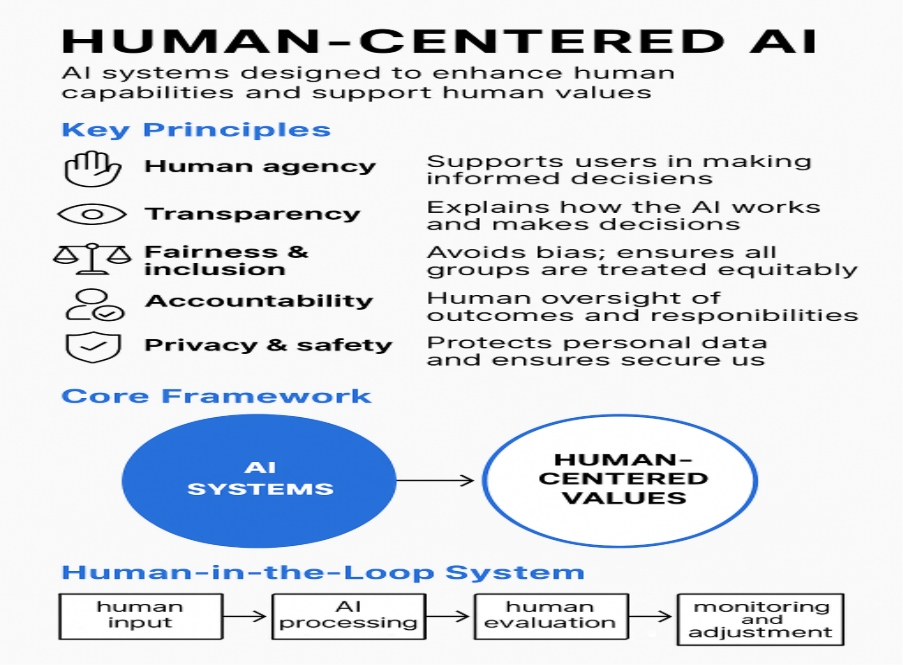Framework 196 The Human-Centred AI (HCAI) Approach
Human-Centered AI (HCAI) refers to the design, development and deployment of artificial intelligence systems that prioritize human values, rights and well-being. It ensures that AI technologies serve people by enhancing human capabilities, fostering trust and enabling equitable participation.
What Is Human-Centered AI?
Human-Centered AI combines principles from:
- ● Human-Computer Interaction (HCI)
- ● Ethics and social science
- ● Artificial intelligence and machine learning
The goal is not just to make AI smarter, but to make it supportive, accountable and beneficial to people.
HCAI often uses a "human-in-the-loop" approach where people are involved at different stages of an AI system:
[Human Input] → [AI Processing] → [Human Evaluation] → [Improved Output]
↑ ↓
[Feedback Loop] ← [Monitoring and Adjustment]
This structure enables adaptability, oversight and trust.

Why HCAI Matters
- ● Builds public trust in AI
- ● Protects human rights and agency
- ● Leads to better outcomes because humans and machines working together can outperform either alone
- ● Ensures AI advances support society’s goals, not just business efficiency.
Key Principles of HCAI
|
Principle |
Meaning/ Description |
|
Empowerment, not replacement |
AI should help people do their jobs better, not eliminate them. |
|
Ethical design |
Systems should be built with fairness, transparency & accountability. |
|
Trust and reliability |
People must be able to trust that AI will behave predictably & safely. |
|
Collaboration between humans & AI |
AI & people work together as a team, each doing what they do best. |
|
Inclusion & accessibility |
AI should work for everyone, considering diverse needs & perspectives. |
|
Human agency |
Supports users in making informed decisions |
|
Transparency |
Explains how the AI works and makes decisions |
|
Fairness & inclusion |
Avoids bias; ensures all groups are treated equitably |
|
Accountability |
Human oversight of outcomes and responsibilities |
|
Privacy & safety |
Protects personal data and ensures secure use |
How HCAI is Different from Traditional AI
|
Traditional AI |
Human-Centred AI |
|
Focus on maximum automation |
Focus on human-AI collaboration |
|
Efficiency & performance are top priorities |
Human dignity, well-being & control are top priorities |
|
Systems often work autonomously |
Systems are supervised, with clear human oversight |
|
"Replace the human" mindset |
"Assist the human" mindset |
Some Examples of HCAI
- ● Education (AI that helps teachers personalize lessons for students, ie adaptive learning system and keeps teachers in control of the classroom.)
- ● Healthcare (diagnostic tools that assist doctors by suggesting possible diagnoses but leave the final decision to the human doctor.)
- ● Workplace Tools (smart assistants, like writing aids or scheduling tools, that enhance, not take over, people's tasks.)
- ● Employment (fair, bias-checked AI tools in hiring)
- ● Urban planning (participatory AI tools used to engage communities in planning process)

Why It Matters
Without a human-centered approach, AI systems risk:
- ● Reinforcing social biases
- ● Acting in ways users can't understand or question
- ● Undermining human decision-making and autonomy
HCAI keeps technology grounded in the real, diverse needs of society.
